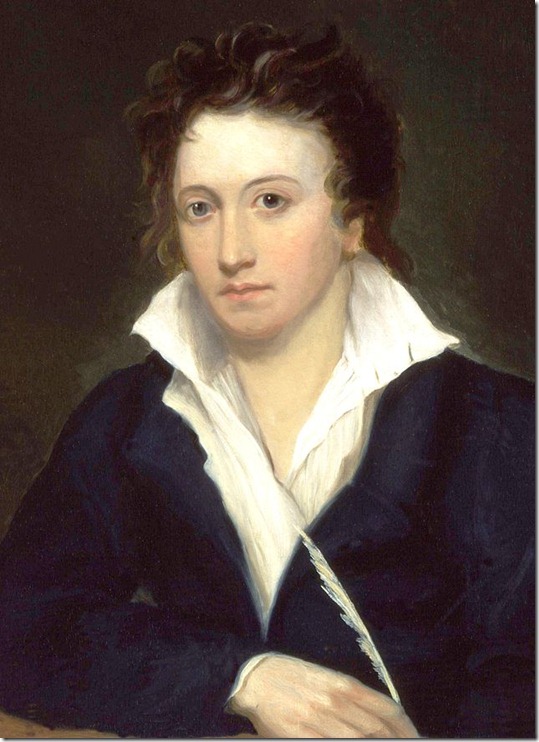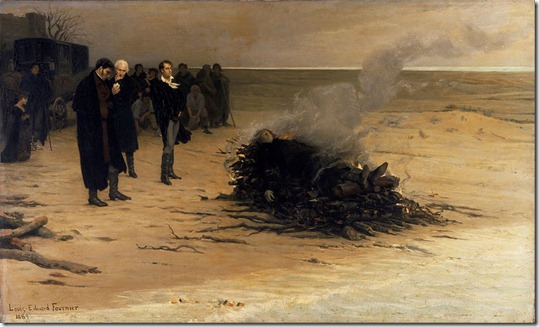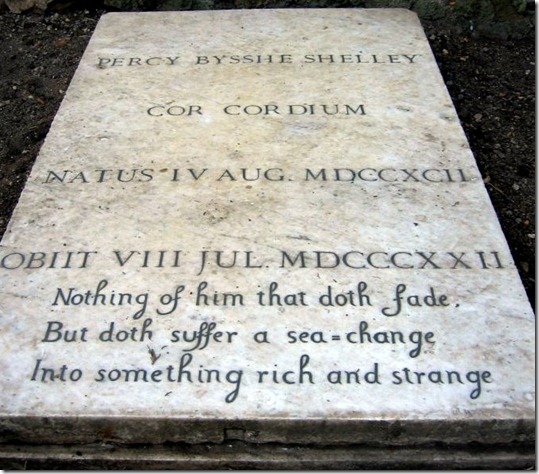Shelley In Italy Posted by Serena on Jul 28, 2014 in Culture
Written by Serena with translation by Geoff
La settimana scorsa sono andata al mare a San Terenzo con mia cognata e mia nipote che erano in vacanza dall’Inghilterra. San Terenzo è un piccolo paese molto carino della costa ligure, fra La Spezia e Lerici. Mia cognata Caroline era già stata a San Terenzo un paio di anni fa, e si ricordava che lì c’era un edificio culturalmente importante per una persona inglese: la casa del poeta Shelley.
Last week I went to the sea at San Terenzo with my sister in law and niece, who were here on holiday from England. San Terenzo is a pretty little village on the Ligurian coast, between La Spezia and Lerici. My sister in law, Caroline, had already been to San Terenzo a couple of years ago, and she remembered that there was a building of cultural significance to an English person: the house of the English poet Shelley.
 |
|
Portrait of Shelley by Alfred Clint (1819) |
Shelley, nel suo peregrinare attraverso l’Europa, visse a San Terenzo con la moglie Mary per alcuni mesi nel 1822, anno della sua morte. In quel periodo venne a trovarlo il suo amico e poeta Lord Byron. Secondo la leggenda Byron, che era un ottimo nuotatore, fece a nuoto tutto il golfo di La Spezia, da Lerici all’estremità est, a Porto Venere che chiude il golfo ad ovest. E’ per la presenza di questi due illustri personaggi inglesi che il Golfo di La Spezia è comunemente conosciuto come il Golfo dei Poeti.
During his wanderings through Europe, Shelley lived in San Terenzo with his wife Mary (author of the famous book ‘Frankenstein’) for a few months in 1822, the year of his death. During that time he was visited by his friend, the poet Lord Byron. According to legend, Byron, who was an excellent swimmer, swam across the Gulf of La Spezia, from Lerici at its eastern extremity, to Porto Venere, which closes the gulf on the west. It is due to the presence of these two famous English personalities that the Gulf of La Spezia is commonly known as the Gulf of the Poets.
Sul litorale di San Terenzo, andando verso Lerici, si trova una bella villa tutta bianca, dalla tipica architettura mediterranea. Ai tempi di Shelley la strada sul lungomare non era ancora stata costruita e la villa si trovava direttamente sulla spiaggia, isolata dal resto del paese. Oggi sulla facciata della villa c’è una targa in marmo con su scritto: “Da questo portico su cui si abbatteva l’antica ombra di un leccio il luglio del 1822 Mary Godwin e Jane Williams attesero con lagrimante ansia Percy Bysshe Shelley, che da Livorno su fragile legno veleggiando, era affondato per improvvisa fortuna ai silenzi delle isole Elisee. O benedette spiagge ove l’amore, la libertà, i sogni non hanno catene”.
Along the coastline on which San Terenzo lies, going in the direction of Lerici, there is a beautiful white, typically Mediterranean, villa. In Shelley’s day the coastal road had not yet been built, and the villa was situated right on the edge of the beach set aside from the rest of the village. Today the facade of the villa carries a marble plaque on which is written: “From this portico upon which the shadow of an ancient oak once fell, in July 1822, Mary Godwin and Jane Williams awaited in tearful anxiety Percy Bysshe Shelley who, while sailing on a fragile craft from Livorno, was taken down by sudden fate to the silence of the Elysium islands. Oh blessed beaches, where love, freedom, and dreams are free” (non hanno catene = literally: don’t have chains).
 |
|
Shelley was cremated on a funeral pyre on the beach at Viareggio and his ashes were interred in Rome. Painting by Louis Édouard Fournier (1889) |
Shelley era andato con la sua barca a vela a Livorno a trovare degli amici. Nel viaggio di ritorno fu sorpreso da un’improvvisa burrasca che fece naufragare la nave. Non è chiaro dove il corpo del poeta e dei suoi compagni di viaggio furono ritrovati. Alcune fonti dicono che furono trascinati a riva a Viareggio, altre parlano di un punto a circa dieci chilometri a nord di Viareggio. Questo mi ricorda un episodio accaduto molti anni fa.
Shelley had gone to Livorno on his sailing boat to visit some friends. On the journey home he was caught up in a sudden storm which sunk his vessel. It’s never been clear exactly where the bodies of the poet and his companions were found. Some sources say they were washed ashore on the beach at Viareggio, others talk about a spot some ten km to the north of the town. This reminds me of an incident that happened many years ago.
 |
|
Shelley’s final resting place in The Protestant Cemetery, Rome. Photo (CC) by Allison Meier. The lines of poetry are taken from Shakespeare’s ‘The Tempest’. |
Era la festa della mia laurea e fra gli invitati c’erano due miei amici che non si conoscevano, e che hanno subito dimostrato reciproca antipatia. I due amici erano Massimo, viareggino DOC, e Francesca, napoletana verace, ma con casa di famiglia per le vacanze a Forte dei Marmi, località a pochi chilometri a nord di Viareggio. Ad un certo punto li ho sentiti ‘disputarsi’ il corpo di Shelley: “Shelley è naufragato a Viareggio” diceva Massimo. “Non è vero, il suo corpo è stato ritrovato a Forte dei Marmi” ribatteva Francesca. “No, a Viareggio, dove adesso c’è Piazza Shelley, per l’appunto” rispondeva Massimo!
It was my graduation party, and amongst the guests were two friends of mine who had never met before, and who immediately took a dislike to each other. The two friends were Massimo, a genuine Viareggino (a person from Viareggio), and Francesca, an authentic Neapolitan who had a family holiday house in Forte dei Marmi, just a few km north of Viareggio. At a certain point I heard them arguing over Shelley’s body: “Shelley was shipwrecked at Viareggio” said Massimo. “It’s not true, his body was found at Forte dei Marmi” replied Francesca. “No, at Viareggio, to be more precise exactly where Piazza Shelley stands” answered Massimo.
Yet another example of the famous Italian campanilismo!

Build vocabulary, practice pronunciation, and more with Transparent Language Online. Available anytime, anywhere, on any device.




Comments:
Robin:
Fascinating. Reminds me of the place in Rome at the bottom of the Spanish steps where Keats lived.
One question: Serena refers to “con la moglie”. Why did you use this instead of “con sua moglie”?
Grazie per la spiegazione in anticipo,
Robin
Serena:
@Robin Ciao Robin! Dire “con sua moglie” è forse più corretto, ma in italiano evitiamo spesso l’aggettivo possessivo quando sappiamo a chi o cosa ci riferiamo, perché ci sembra rindondante. E’ normale dire “Maria ha portato il figlio a scuola prima di fare la spesa”, perché ovviamente stiamo parlando di suo figlio. E infatti non usiamo mai il possessivo con parti del corpo, ex: “Mario si è rotto il braccio”, non “Mario si è rotto il suo braccio”. Va bene?
Saluti da Serena
P.S. Tanti artisti stranieri, in particolare Inglesi, Francesi e Tedeschi hanno vissuto in Italia nel periodo del cosiddetto “Gran Tour d’Italia” (1700-1800).
Giacomo Sileo:
Carissimi Serena e Goeff,
Grazie tantissima per quest’articolo!!!
Ciao,
Giacomo
Marco:
Nella targa i bellissimi versi di Ceccardo Roccatagliata Ceccardi.Poeta ligure apuano poco conosciuto ma ispirato come pochi.
Serena:
@Marco Grazie Marco per la precisazione.
Saluti da Serena